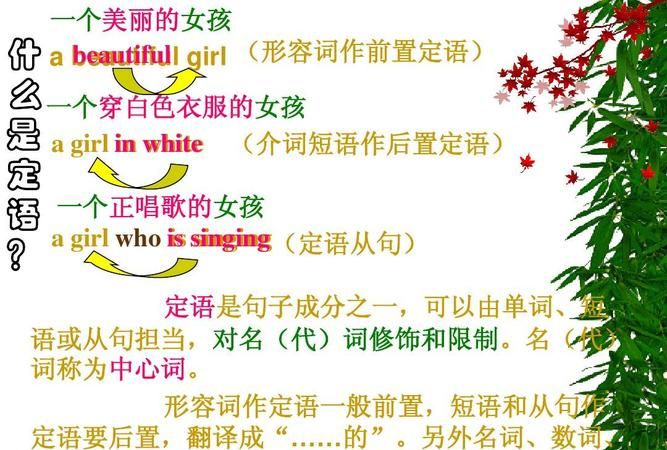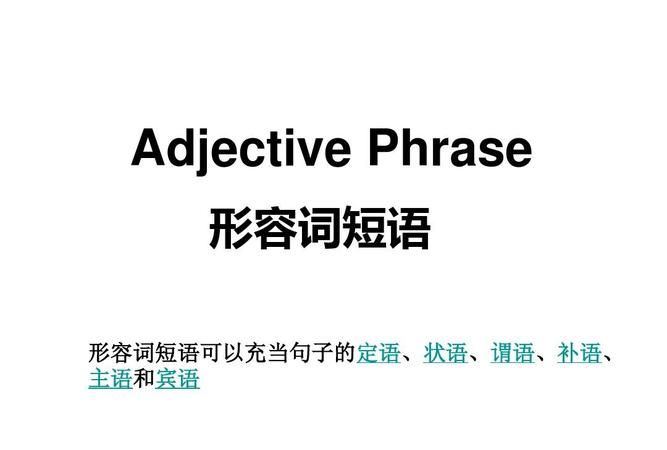本文目录
形容词做后置定语的结构
下面的回答 供参考
1.修饰不定代词时:修饰somebody,someone,something,anybody,anyone,anything,nobody,nothing等复合不定代词的形容词,则必须放在不定代词之后.如:
This isn’t anything important.这并不是什么重要的东西.
Anyone intelligent can do it.任何有脑子的人都能做这事.
There’s nothing wrong with the machine.机器没有毛病.
Let’s talk about something interesting.我们来谈论一些有趣的事吧.
2.形容词短语作定语时:形容词短语作定语必须放在所修饰的名词之后.如:
I think he is a man suitable for the job.我认为他是适合做这项工作的人.
We need a place twice larger than this one.我们需要一个比这里大一倍的地方.
3.成对的形容词作定语时:有时成对的形容词作定语,考虑到句子的节奏和平衡,可以后置.如:
There was a huge cupboard,simple and beautiful.有一个大食橱,简朴而美观.
She has many pencils,blue and red.她有许多铅笔,有蓝的、红的.
4.表语形容词作定语时:当表语形容词作定语时必须放在所修饰的名词之后.如:
He must be the best violinist alive.他一定是当代最好的小提琴手了.
The house ablaze is next door to me.那家着火的房子就在我隔壁.
有时形容词作定语时,既可放在被修饰名词之前,也可放在被修饰名词之后.当past,last,next,nearby,following等作定语时,既可放在所修饰的名词之前,也可放在所修饰的名词之后.如:
in past years / in years past 过去的年月
the following days / the days following 以后的日子
另外,形容词enough,opposite等修饰名词时可前置或后置.如:
If we had enough time [time enough],things would be easy.如果时间足够,事情就好办了.
The people in the house opposite [the opposite house] never draw their curtains.对面房子里的人从来不把窗帘拉上.
注意,有的形容词前置和后置均可,但含义不同.如:
What’s your present feeling?你现在感觉如何?(present=现在的)
He was the only Englishman present.他是唯一在场的英国人.(present=在场的)
另外,有些既可用作形容词又可用作副词的词,当它用作形容词时前置,用作副词时后置.如:
upstairs rooms / rooms upstairs 楼上的房间

形容性物主代词作定语名词性物主代词作主表语的句子各5条带译文
形容词性物主代词作定语:
This is my book.这是我的书.
That is your pencil box.那是你的铅笔盒.
It is his cup.那是你的杯子.
These are their bags.这些是他们的包.
It is her school bag.那是她的书包.
名词性物主代词作主、表语:
The book is mine.(作表语)这本书是我的.
This is a pencil.It(作主语) is yours.(作表语)这是一支铅笔,它是你的.
This apple is hers.(作表语)这个苹果是她的.
I have an apple,it(作主语) is red and yours(作主语) is green.我有一个苹果,它是红色的,你的是青色的.
These books are theirs.(作表语)

形容词性定语从句例子
形容词性定语从句例句已经为大家整理好啦,一起来阅读以下句子吧
1.定语从句:修饰一个名词或代词的从句称为定语从句,一般紧跟在它所修饰的先行词后面
.2.关系词:引导定语从句的关联词称为关系词,关系词有关系代词和关系副词.关系代词有that, which, who, whom, whose, as等;关系副词有where, when, why等.关系词常有3个作用:1,引导定语从句.2,代替先行词.3,在定语从句中担当一个成分.
,名词,代词,数词,分词,副词,不定式以及介词短语来担任,也可以由一个句子来担任.
定语从句是由关系代词或关系副词引导的从句,其作用是作定语修饰主句的某个名词性成分,相当于形容词,所以又称为形容词性从句.
I. 限制性定语从句的特殊用法
II. 非限制性定语从句
III. 同位语从句
IV. 同位语从句和定语从句的区别
I. 限制性定语从句的特殊用法
1. way + 定语从句 way 后面跟定语从句有三种形式.
(1) way + in which + 定语从句
例如:
She was pleased with the way in which he had accepted her criticism.
(2) way + that +定语从句
例如:
They didn’t do it in the way that we do now.
(3) way + 定语从句
例如:
He didn’t speak the way I do.
2. as 引导的定语从句
(1) 在由 as 引导的定语从句中所修饰的词(先行词)前面常有 such 或 the same.
例如:
Such people as you describe are rare nowadays.
I have the same trouble as you (have).
(2) As 在定语从句中可以作主语、宾语或表语.
例如:
Let’s discuss only such questions as concern everyone of us.(作主语)
I never heard such stories as he tells.(作宾语)
I’ve never seen such a clever man as he is.(作表语)
(3) As 有时引导非限制性定语从句,可在定语从句中作主语、宾语、表语,修饰主句,常解释为正如、如同.
例如:
As is known to all, the earth moves round the sun.(作主语)
As was expected, he performed the task with success.(作主语)
As he predicted, the wind changed.(作宾语)
The meeting is very important, as indeed it is.(作表语)
II. 非限制性定语从句
1.非限制性定语从句由 who, whom, which 引导(不可用 that),还可以由 whose, when, where 等词引导.
非限制性定语从句要用逗号隔开,非限制性定语从句可以删去,整个句子的意思还是完整的,而限制性定语从句如果被删去,句子的意思不完整.
例如:
Mr Brown, who is our English teacher, lives near our school.
Yesterday I met my son’s school master, whom you saw at my home last year.
He has finished the difficult exercise, which is easy for you.
The factory is headed by a 35-year-old man, whose wife is from America.
They will fly to Qingdao, where they plan to stay for two weeks.
In these days, when I was a child, the city had no industry to speak of.
注意:非限制性定语从句中的关系词是不可省略的.
2.非限制性定语从句有时并非修饰名词或代词,它可以修饰整个句子.
例如: They have invited me to visit their country, which is very kind of them.
3..in front of, at the back of, in the middle of 等短语在定语从句中的用法.
如果关系代词是作这类介词短语的宾语时,介词短语必须提前.
例如:
Yesterday afternoon we arrived at his log cabin, in front of which stood a talltree.
4.注意此类句子表达方式.
There are forty students in their class, thirty of whom are League members.
也可以改成
There are forty students in their class, of whom thirty are League members.
III.同位语从句
同位语从句常跟在 idea, fact, doubt, thought, belief, news, hope 等词后面,由连接代词 that(不可用 which)和连接副词 when, where, whether 等引导.
例如:
I had no idea that you were here.
The fact that he is unfit for his job is quite clear.
Then arose the question where we were to get the machine needed.
All the time she was in bitter doubt whether she was right.
I V.同位语从句和定语从句的区别
同位语从句用于名词后面,对该名词的内容作进一步说明,连接词在从句中不作成份.
定语从句用于修饰名词或代词,引导定语从句的关系代词或关系副词往往在定语从句中作一个成份.
例如: Have you heard the news that Mr Smith will come to give a lecture on Irish Fairy Tales? 这里 that 引导的是同位语从句,不可以用 which 代替 that, 连接代词在从句中不作成份.
Have you told him the news that I told you last week?
这里 that 引导的是定语从句,可以用 which 代替 that,它在定语从句中作宾语
1.定语从句:修饰一个名词或代词的从句称为定语从句,一般紧跟在它所修饰的先行词后面.2. 关系词:引导定语从句的关联词称为关系词,关系词有关系代词和关系副词.关系代词有that, which, who, whom, whose, as等;关系副词有where, when, why等.关系词常有3个作用:1,引导定语从句.2,代替先行词.3,在定语从句中担当一个成分.
,名词,代词,数词,分词,副词,不定式以及介词短语来担任,也可以由一个句子来担任.
定语从句是由关系代词或关系副词引导的从句,其作用是作定语修饰主句的某个名词性成分,相当于形容词,所以又称为形容词性从句.
2 定语
一) 限定性定语从句
1. that既可代表事物也可代表人,which代表事物;它们在从句中作主语或宾语,that在从句中作宾语时常可省略关系词,which在从句中作宾语则不能省略.而且,如果which在从句中作“不及物动词+介词”的'介词的宾语,注意介词不要丢掉,而且介词总是放在关系代词which的前边,但有的则放在它原来的位置
2. which作宾语时,根据先行词与定语从句之间的语义关系,先行词与which之间的介词不能丢
3. 代表物时多用which,但在带有下列词的句子中用that而不用which,这些词包括当先行词是anything, everything, nothing ,few, all, none, little, some等代词时,或者是由every, any, all, some, no, little, few, much等修饰时等,这时的that常被省略
4. who和whom引导的从句用来修饰人,分别作从句中的主语和宾语,whom作宾语时,要注意它可以作动词的宾语也可以作介词的宾语
5. where是关系副词,用来表示地点的定语从句
6. when引导定语从句表示时间〔注〕值得一提的是,表示时间“time"一词的定语从句只用when引导,有时不用任何关系代词,当然也不用that引导
By the time you arrive in London, we will have stayed there for two weeks. I still remember the first time I met her. Each time he goes to business trip, he brings a lot of living necessities, such as towers, soap, toothbrush etc.
7. whose是关系代词,修饰名词作定语,相当于所修饰成分的前置所有格.它引导的从句可以修饰人和物, 当它引导的从句修饰物体时, 可以与 of which 调换,表达的意思一样.
8. 当从句的逻辑主语是some, any, no, somebody, anybody, nobody, something, anything, everything或nothing时,常用there is来引导
There is somebody here who wants to speak to you. 这里有人要和你说话.

形容词短语作后置定语的英语句子
这里bent on making a discovery作用相当于定语从句who is bent on making a discovery.
这里是过去分词短语作后置定语,而不是作状语.
过去分词短语作后置定语的情形很常见,大多可直接改写为”who/which/that +be +过去分词+其它“这种定语从句.
He took away the umbrella hung on the pole.
他把杆子上挂着的雨伞拿走了.
Do you know the girl seated by the general manager?
你认识在总经理旁边就座的那个女孩吗?

以上就是关于形容词作定语的句子 ,形容词做后置定语的结构的全部内容,以及形容词作定语的句子 的相关内容,希望能够帮到您。

